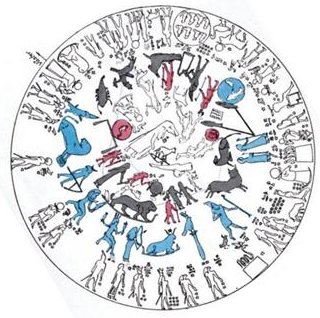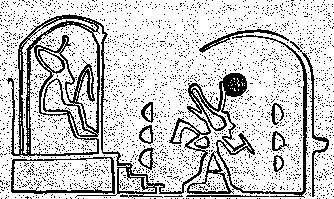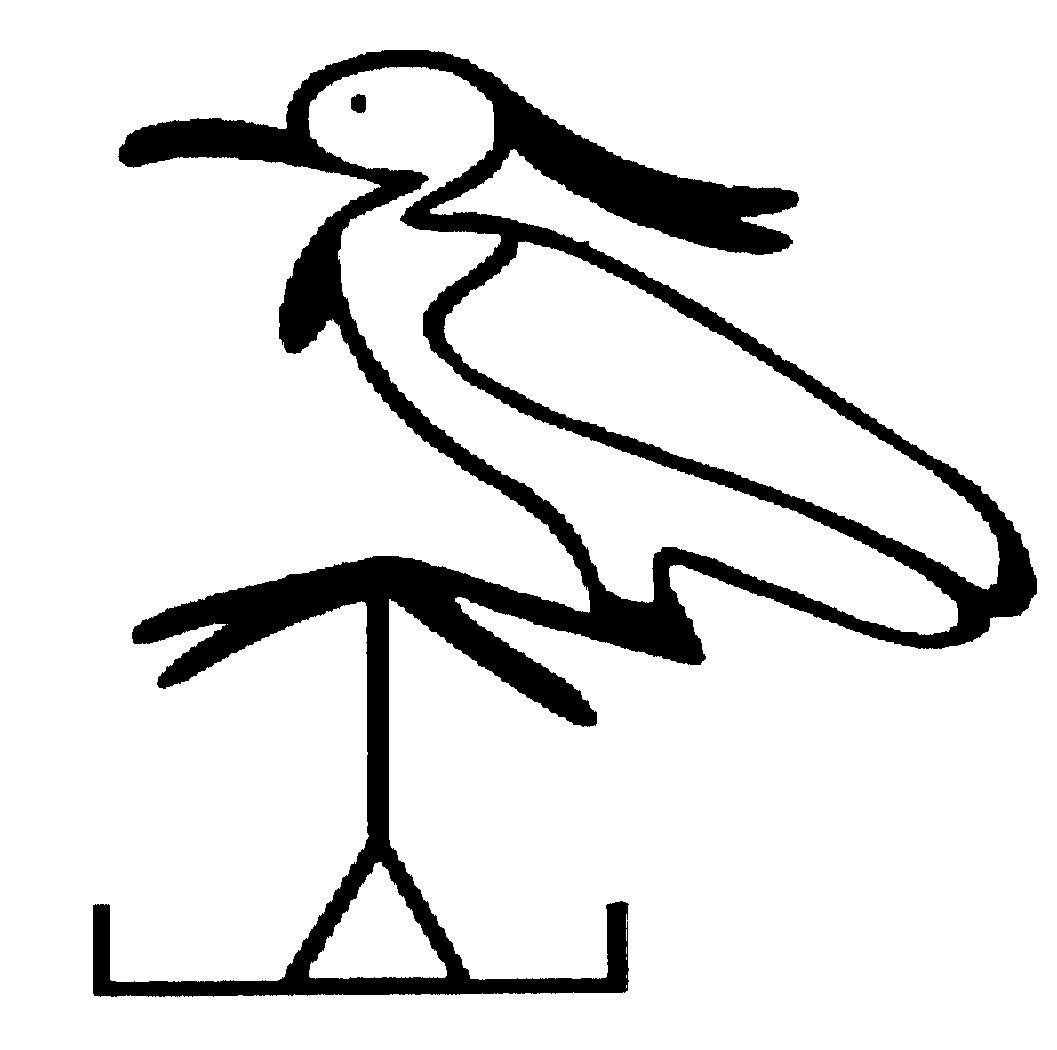The first obvious example, which also should be useful for us, is the stone which covered the hidden Hotua Matua skull: ... When Tuu Ko Ihu came out and sat on the stone underneath which he had buried the skull, Ure Honu shot into the house like a lizard. He lifted up the one side of the house. Then Ure Honu let it fall down again; he had found nothing. Ure Honu called, 'Dig up the ground and continue to search!' The search went on. They dug up the ground, and came to where the king was. The king (was still) sitting on the stone. They lifted the king off to the side and let him fall. They lifted up the stone, and the skull looked (at them) from below. They took it, and a great clamour began because the skull had been found ... Ure is the proper owner of the skull and lifting the side of the hare paega he 'rises the sky dome' as is done in spring. But the skull was not there, it had moved on to the bottom of a hole. Digging up the ground was necessary. The skull must be in the 'underworld', because it follows spring. Reality moves in cycles and beyond the top there must come a rock bottom phase, the reverse of how beyond Te Pei comes Te Pou. Tuu Ko Ihu was forcefully removed from the stone he sat upon and he fell like Taurus depicted in the Dendera round zodiac:
But the skull had been hidden in a hole earlier too: "... Night came, midnight came, and Tuu Maheke said to his brother, the last-born: 'You go and sleep. It is up to me to watch over the father.' (He said) the same to the second, the third, and the last. When all had left, when all the brothers were asleep, Tuu Maheke came and cut off the head of Hotu A Matua. Then he covered everything with soil. He hid (the head), took it, and went up. When he was inland, he put (the head) down at Te Avaava Maea. Another day dawned, and the men saw a dense swarm of flies pour forth and spread out like a whirlwind (ure tiatia moana) until it disappeared into the sky. Tuu Maheke understood. He went up and took the head, which was already stinking in the hole in which it had been hidden. He took it and washed it with fresh water. When it was clean, he took it and hid it anew. Another day came, and again Tuu Maheke came and saw that it was completely dried out (pakapaka). He took it, went away, and washed it with fresh water until (the head) was completely clean. Then he took it and painted it yellow (he pua hai pua renga) and wound a strip of barkcloth (nua) around it. He took it and hid it in the hole of a stone that was exactly the size of the head. He put it there, closed up the stone (from the outside), and left it there. There it stayed ... The recycling of the head seems to take a year, and the sun must stand exactly in the right position: Another year passed, and a man by the name of Ure Honu went to work in his banana plantation. He went and came to the last part, to the 'head' (i.e., the upper part of the banana plantation), to the end of the banana plantation. The sun was standing just right for Ure Honu to clean out the weeds from the banana plantation. On the first day he hoed the weeds. That went on all day, and then evening came. Suddenly a rat came from the middle of the banana plantation. Ure Honu saw it and ran after it. But it disappeared and he could not catch it. On the second day of hoeing, the same thing happened with the rat. It ran away, and he could not catch it. On the third day, he reached the 'head' of the bananas and finished the work in the plantation. Again the rat ran away, and Ure Honu followed it. It ran and slipped into the hole of a stone. He poked after it, lifted up the stone, and saw that the skull was (in the hole) of the stone. (The rat was) a spirit of the skull (he kuhane o te puoko). The spirit of Hotu Matua (in form of the rat) had to lead the way, not much different from how in ancient Egypt there was an 'Opener of the Way', Upwaut, for the king to be installed:
Upwaut was not a rat but another quadruped, a wolf. There are no wolves on Easter Island. The right time for cleaning up banana plantations was Ko Ruti according to Barthel 2:
It must be summer because the days are described as long and the sun becomes too hot for work in the middle of the day. But Ure worked all day long, 3 days in a row. Number 3 informs us that it is not a question of ordinary days, what is meant are the 3 periods of spring. This is confirmed by Ure hanging the skull high: ... Ure Honu was amazed and said, 'How beautiful you are! In the head of the new bananas is a skull, painted with yellow root and with a strip of barkcloth around it.' Ure Honu stayed for a while, (then) he went away and covered the roof of his house in Vai Matā. It was a new house. He took the very large skull, which he had found at the head of the banana plantation, and hung it up in the new house. He tied it up in the framework of the roof (hahanga) and left it hanging there ... Ko Ruti was the 11th month of the year, which means a new year must begin in summer:
According to Barthel 2 Ko Ruti was November (which is the 11th month of our own calendar too). But south of the equator it was spring. If a calendar for the year is based on the sun's movement against the background of the stars, then it is necessary to change winter to summer, spring to autumn, etc, when crossing the equator. In ancient Egypt the king was reinstalled (or possibly a new king installed) at the Sed festival:
When land reappears after the 'flood' it is the proper time to install a new king:
... In ancient Egypt there was also a special type of bird to indicate this, the benu bird (named phoenix by the Greeks). According to Wilkinson the benu bird was a heron (Ardea cinerea - cǐnis = ashes) and '... standing for itself on an isolated rock or on a little island in the middle of the water the heron was an appropriate image for how the first life appeared on the primary hill which arose from the watery chaos at the time of the original creation.' 'Similarly to the sun the heron rose up from the primary waters, and its Egyptian name, benu, was probably derived from the word weben, to 'rise' or 'shine'. This magnificent wader was also associated with the inundations of the Nile.' The benu in the picture perches - which could signify solstice - on a single inverted 'sky pillar', and it ought to symbolize how the sky pillar of spring has been turned upside down. The result is darkness, because the sky roof now lies upon the earth. (Had it been 2 inverted sky pillars it would have meant 'cloth', menchet.) In rongorongo the henua ora glyph type could be a corresponding sign:
In Ga7-7 henua ora has additional signs, e.g. with the 8 + 8 'feather' marks probably indicating that Sun is not visible (cfr at maro). The day number is 6 * 29.5 = 177, or 240 + 1 if counted from winter solstice. The full measure for Spring Sun seems here to be considered as 240 days. The 'tail of the bull' (which pharaoh had on his kilt) surely must represent the 'end part' of the preceding 'bull' (pharaoh). On Easter Island the 'House Document' could be the skull of 'Hotu Matua'. The Two Partners could represent the 'front side' and the 'back side' of the year. There were 21 + 21 underground judges in the Hall of Two Truths (cfr at tagata), and if we count with fortnights, we can see that there should have been a need for 'one more' day than 21 * 14 = 294 days for half the assembly. 2 * (294 + 1) = 590 or 10 lunar doublemonths. The 'darkness at noon' (when the skull was hidden in a hole under a stone or the king disappeared into the palace chapel) ought to be reflected in the starry sky - or even better, it should be a reflection down on earth of what could be observed in the sky. The Moon disappears in her 29th night in order to be rejuvenated. |



